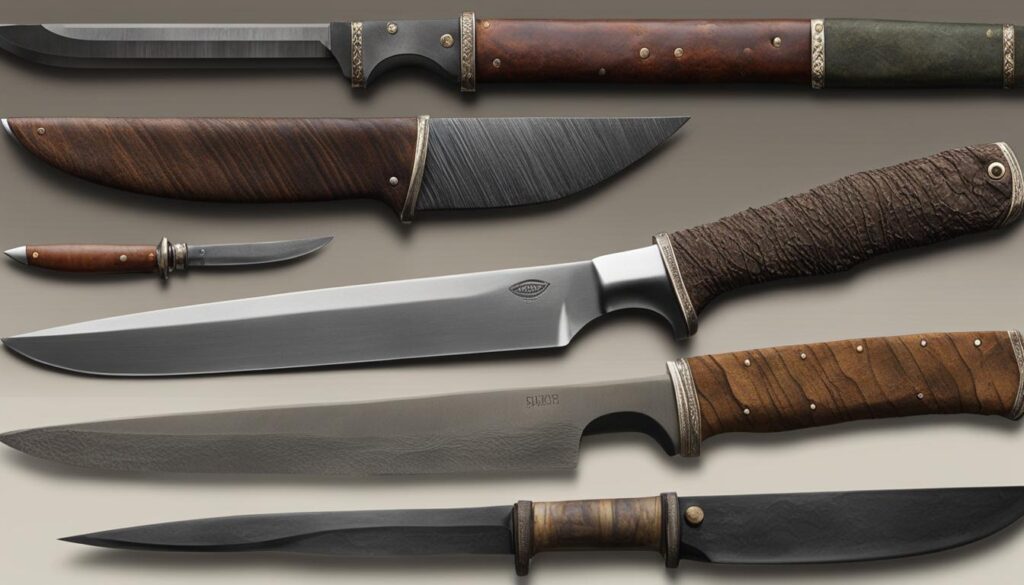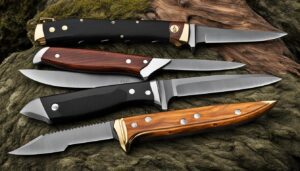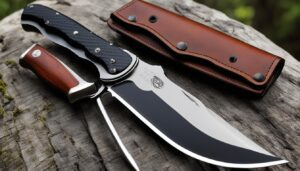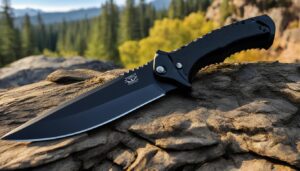Hunting knives are indispensable tools for outdoor enthusiasts and hunters embarking on wilderness trips. These knives offer the usability, adaptability, and dependability required in the rugged and unpredictable backcountry. Whether you are an experienced hunter or a novice explorer, a high-quality hunting knife is a must-have for tasks like skinning game, cutting through vegetation, and even self-defense. To ensure you have the right tool for your wilderness adventures, it is important to consider various factors when selecting a hunting knife.
Factors such as the shape and type of blade, the type of steel used, the handle material, the tang design, and the sheath are all critical considerations. By carefully evaluating these factors, you can confidently choose a hunting knife that meets your specific needs and enhances your overall outdoor experience.
Key Takeaways:
- Choosing the right hunting knife is essential for wilderness trips.
- Factors such as blade shape, steel type, handle material, tang design, and sheath should all be considered.
- A high-quality hunting knife provides usability, adaptability, and dependability in the wilderness.
- Select a hunting knife that suits your needs and preferences to enhance your outdoor experience.
- Proper maintenance and care are crucial for the longevity and optimal performance of your hunting knife.
Criteria to Choose the Right Hunting Knife
When it comes to selecting a hunting knife for your wilderness adventures, there are several important criteria to consider. These factors will help ensure that you choose a knife that is well-suited for your specific needs and preferences.
Blade Shape and Type
The shape and type of the blade are crucial considerations when choosing a hunting knife. Some common blade shapes include drop point, clip point, and tanto. Each shape has its advantages and is suitable for different tasks. For example, a drop point blade offers a strong, sharp point and is ideal for general-purpose use, while a clip point blade has a more delicate point and is suitable for precision tasks.
Type of Steel
The type of steel used in the blade greatly impacts its performance. Stainless steel is popular for its corrosion resistance and low maintenance, making it suitable for outdoor use. On the other hand, carbon steel blades provide exceptional strength and edge retention but require more maintenance to prevent rust. Consider your needs and the environment in which you will be using the knife to determine the best type of steel for your hunting knife.
Handle Material
The handle material plays a significant role in the comfort and grip of the knife. Common handle materials include wood, rubber, plastic, and artificial composites. Wood handles are aesthetically pleasing but may require more maintenance. Rubber handles offer excellent grip and are ideal for wet and slippery conditions. Plastic and composite handles are lightweight and durable. Choose a handle material that feels comfortable in your hand and offers a secure grip.
Tang Design
The tang design refers to the portion of the blade that extends into the handle. A full tang design means that the blade extends throughout the entire length of the handle, providing maximum strength and durability. A partial tang design, on the other hand, means that the blade extends only partially into the handle. Full tang knives are generally preferred for their robustness and reliability in demanding outdoor tasks.
Sheath
The sheath is an essential accessory for a hunting knife, as it provides safe storage and convenient transportation. It should be sturdy and reliable, offering secure retention of the knife while allowing for quick and easy access when needed. Consider the materials used, such as leather or synthetic materials, and ensure that the sheath is well-designed and durable.
By carefully evaluating these criteria and considering your specific needs, you can confidently choose the right hunting knife for your wilderness adventures. Remember to prioritize functionality, comfort, and durability, as these factors will contribute to your overall satisfaction and performance in the field.
Types of Hunting Knives for Wilderness Adventures
When it comes to wilderness adventures, having the right hunting knife is essential. There are various types of hunting knives available, each designed for different purposes. Let’s take a closer look at some of the most popular types:
1. Survival Knife
A survival knife is a versatile tool that can be used for a wide range of wilderness tasks. It often features a fixed blade and a strong, durable construction. Survival knives are designed to handle tough conditions and can be used for tasks like building shelters, preparing food, and even self-defense.
2. Folding Knife
A folding knife is known for its compactness and portability. It features a folding mechanism that allows the blade to be safely tucked away when not in use. Folding knives are convenient for everyday carry and can be easily stored in a pocket or backpack. They are ideal for tasks that require precision and versatility.
3. EDC Knife
An EDC (Everyday Carry) knife is designed to be an all-purpose tool that you can carry with you wherever you go. It is typically compact in size and features a folding blade. EDC knives are great for various outdoor activities, from camping and hiking to hunting and fishing. They are versatile and reliable tools for everyday wilderness adventures.
4. Multi-Tool Knife
A multi-tool knife is a combination of a knife and several other tools, such as pliers, screwdrivers, and bottle openers. It is a compact and convenient tool for outdoor enthusiasts who need multiple functionalities in a single tool. A multi-tool knife is perfect for camping trips, fishing expeditions, and other wilderness adventures where versatility is key.
5. Fishing Knife
A fishing knife is specially designed for anglers and fishermen. It typically features a thin and flexible blade that is ideal for cleaning and preparing fish. Fishing knives come in various sizes and designs, allowing anglers to choose the most suitable option for their specific needs.
When choosing a hunting knife for your wilderness adventures, consider the type that best fits your needs and the tasks you will be performing. Each type of hunting knife has its own advantages and features, so take the time to find the one that suits your preferences and requirements.
| Type of Hunting Knife | Features |
|---|---|
| Survival Knife | Versatile, fixed blade, durable construction |
| Folding Knife | Compact, portable, folding mechanism |
| EDC Knife | All-purpose, compact, folding blade |
| Multi-Tool Knife | Combination of knife and other tools, versatile |
| Fishing Knife | Thin, flexible blade, ideal for cleaning fish |
Top Picks for Hunting Knives
When it comes to selecting the perfect hunting knife for your wilderness trips, it’s essential to choose one that combines durability, functionality, and reliability. To help you make an informed decision, here are some top picks for hunting knives based on their features and customer reviews:
1. Outdoor Edge RazorLite EDC Knife
This pocket knife is a popular choice for its versatility and convenience. It features replaceable blades, allowing you to easily switch out the blade when needed. With a convenient pocket clip, the Outdoor Edge RazorLite EDC Knife can be securely carried with you on your wilderness adventures.
2. Grand Way Black Spring Assisted Pocket Knife 6681-1
If you’re looking for a military-style folding knife, this option is worth considering. The Grand Way Black Spring Assisted Pocket Knife 6681-1 is designed for camping, hunting, and survival situations. With its folding mechanism, it offers compactness and portability without compromising on durability.
3. Outdoor Edge RazorPro L Hunting Knife
Known for its razor-sharp blade, the Outdoor Edge RazorPro L Hunting Knife is a reliable choice. It features a non-slip handle for a secure grip and easy handling. Whether you need it for skinning, cutting, or self-defense, this hunting knife will not disappoint.
4. Buck Knives 110 Folding Hunter Knife
If you prefer a classic look, the Buck Knives 110 Folding Hunter Knife is a timeless option. This lock-back knife is crafted with durability in mind, ensuring it can withstand the demands of your wilderness adventures. Its sturdy construction and reliable performance make it a favorite among hunters.
5. Outdoor Edge WildGuide Hunting Knife Set
If you’re looking for a complete hunting knife set, the Outdoor Edge WildGuide Hunting Knife Set is worth considering. It includes multiple knives and a bone saw, providing you with the tools needed for precision and durability in deer processing. With this set, you’ll be well-equipped for various hunting tasks.
These top picks for hunting knives offer a range of options to suit different preferences and needs. Whether you prioritize portability, versatility, or classic design, these knives deliver on performance and reliability. By choosing one of these top-rated hunting knives, you can ensure a successful and enjoyable wilderness adventure.
Maintenance and Care Tips for Hunting Knives
Proper maintenance and care are essential for ensuring the longevity and optimal performance of your hunting knife. By following these tips, you can keep your knife in excellent condition throughout your wilderness adventures.
Cleaning
After each use, it’s important to clean your hunting knife thoroughly. Use a mild soap and warm water to remove any dirt, debris, or residue from the blade and handle. Avoid using harsh chemicals or abrasives that can damage the knife’s finish.
Sharpening
Regular sharpening is key to maintaining a sharp and effective blade. Use a sharpening stone or honing rod to sharpen the edge of your knife. Start with a coarse grit and gradually move to a finer grit for a polished edge. Be sure to follow the manufacturer’s recommendations and techniques for sharpening your specific knife.
Lubrication
Applying a thin layer of lubricant to the pivot area of your folding or assisted-opening knife can help ensure smooth and reliable operation. Use a lubricant specifically designed for knife maintenance, such as a light oil or silicone-based lubricant. Apply a small amount and wipe away any excess to prevent attracting dirt or debris.
Storage
Proper storage is crucial for protecting your hunting knife from moisture, humidity, and other environmental factors. Store your knife in a dry and cool area, away from direct sunlight and extreme temperatures. Consider using a knife pouch, sheath, or storage case to prevent accidental damage and ensure the blade’s sharpness is preserved.
Routine Inspection
Regularly inspect your hunting knife for any signs of wear, damage, or loose components. Check the blade for chips, cracks, or bent edges, and ensure the handle is securely attached to the tang. If the knife shows any signs of damage or malfunction, it’s important to address the issue promptly to prevent further deterioration and maintain safe usage.
By following these maintenance and care tips, you can extend the lifespan of your hunting knife and preserve its performance in the wild. Taking the time to care for your knife will ensure that it remains a reliable companion on your wilderness adventures.
Further Exploration in the World of Knives and Outdoor Activities
To truly immerse yourself in the world of knives and outdoor activities, there are various avenues you can explore that will enhance your knowledge and skills. From knife skills workshops to outdoor survival courses, there are opportunities to learn new techniques and gain invaluable experience.
Attending knife skills workshops is a great way to improve your proficiency in handling knives and honing your cutting techniques. These workshops often cover topics such as proper grip, knife safety, and different cutting styles. Participating in these sessions will not only enhance your skills but also provide you with the confidence to handle knives effectively in a range of situations.
Another option to consider is enrolling in outdoor survival courses. These courses offer practical training on wilderness survival skills, including navigation, shelter-building, fire-making, and foraging. Learning these skills will not only broaden your outdoor capabilities but also deepen your appreciation for the role that knives play in survival situations.
Connecting with the Knife Community
Beyond the workshops and courses, connecting with the knife community can be a rewarding experience. Online forums and social media groups dedicated to knives and outdoor enthusiasts provide a platform for knowledge-sharing, discussions, and networking. Engaging with like-minded individuals will expand your understanding of knives, give you access to valuable insights, and foster a sense of community.
If you’re passionate about customization, there are opportunities to explore knife customization. Many knife enthusiasts enjoy personalizing their knives by adding unique handle materials, engravings, or decorative elements. Customizing knives allows you to create a piece that reflects your individual taste and style.
Finally, for those who appreciate the artistry and functionality of knives, expanding your collection can be a fulfilling pursuit. Acquiring knives with different designs, materials, and functionalities broadens your understanding of the diverse options available. It also allows you to appreciate the craftsmanship and innovation that goes into each knife.
By engaging in these activities, you will deepen your knowledge, sharpen your skills, and develop a strong connection to the world of knives and outdoor adventures.

The History and Evolution of Knives
Knives have a rich and fascinating history that spans thousands of years. They were one of the earliest tools created by humans, dating back to the Stone Age. Our ancestors used sharp-edged stones and bones to cut, slice, and hunt for survival. Over time, the design and functionality of knives evolved as people discovered new materials and techniques.
The origins of knives can be traced back to various civilizations around the world. In ancient Egypt, for example, knives were used for ceremonial purposes and as symbols of power. The Romans were known for their craftsmanship and created intricate folding knives with ornate handles. In Asia, traditional Japanese knives were renowned for their precision and sharpness, with the art of knife-making passed down through generations.
With the advent of the Iron Age, knives began to be made from metal, providing increased durability and versatility. The Industrial Revolution brought significant advancements in knife production, with the introduction of factory-made blades and innovative manufacturing techniques. Today, knives have evolved into a wide range of styles and purposes, from everyday carry knives to specialized tools for hunting, survival, and culinary arts.
“The history of knives is a testament to human ingenuity and resourcefulness. The evolution of these tools reflects our constant quest for improvement and adaptability in the face of ever-changing needs and challenges.”
Exploring the history and evolution of knives not only offers valuable insights into the development of a fundamental tool but also provides a glimpse into the ingenuity and creativity of human civilization throughout the ages.
The Evolution of Knives
The evolution of knives can be seen in various aspects of their design and construction:
- The materials used for blades have transitioned from stone and bone to metals such as iron, steel, and stainless steel, providing improved strength and sharpness.
- Advancements in manufacturing techniques have allowed for the production of different blade shapes and types, including drop point, clip point, tanto, and more.
- Handles have evolved from simple materials like wood and bone to synthetic materials such as rubber, micarta, and G-10, offering enhanced grip and durability.
- Modern knives feature innovative opening mechanisms, such as assisted opening, automatic, and flipper, for quick and easy access to the blade.
- Specialized knives have been developed for specific purposes, such as survival knives with built-in tools and features, and tactical knives for military and law enforcement use.
The evolution of knives is a testament to human ingenuity and the continuous pursuit of functionality, durability, and efficiency in our everyday tools.
| Knife Design | Features |
|---|---|
| Stone Age | Knives made from stone and bone |
| Ancient Civilizations | Symbolic and ceremonial knives |
| Iron Age | Introduction of metal blades |
| Industrial Revolution | Mass production and factory-made blades |
| Modern Era | Specialized designs and advanced materials |


Conclusion
When it comes to choosing the perfect hunting knife for your wilderness adventures, it’s important to consider various factors. The blade shape, type of steel, handle material, tang design, and sheath all play a crucial role in determining the usability and dependability of your hunting knife. By carefully evaluating these criteria, you can make an informed decision and select a knife that meets your specific needs and preferences.
Once you’ve chosen your ideal hunting knife, it’s essential to take proper care of it to ensure its longevity and optimal performance. Regular cleaning, sharpening, lubrication, and routine inspections are key maintenance tasks that will keep your knife in excellent condition. By following these care tips, you’ll be able to rely on your hunting knife for years to come.
Furthermore, to delve deeper into the world of knives and outdoor activities, you can consider attending knife skills workshops, joining online communities, or enrolling in survival courses. These opportunities will not only expand your knowledge and skills but also allow you to connect with fellow enthusiasts who share your passion. Additionally, exploring customization options and expanding your collection can further enhance your appreciation for these versatile tools.
In conclusion, by carefully considering the factors outlined in this guide, maintaining your hunting knife, and exploring the endless possibilities in the knife world, you can embark on wilderness adventures with confidence and pleasure. So, choose your perfect hunting knife, embrace the outdoor experience, and let your wilderness adventures begin.
FAQ
What factors should I consider when choosing a hunting knife?
Factors like the shape and type of blade, the type of steel used, the handle material, the tang design, and the sheath should be considered when choosing the right hunting knife.
What are the different types of hunting knives available?
Some popular options include fixed-blade knives, survival knives, folding knives, EDC knives, multi-tool knives, and fishing knives.
Can you recommend some top hunting knives?
Sure! Some top picks include the Outdoor Edge RazorLite EDC Knife, the Grand Way Black Spring Assisted Pocket Knife 6681-1, the Outdoor Edge RazorPro L Hunting Knife, and the Buck Knives 110 Folding Hunter Knife.
How should I take care of my hunting knife?
Proper maintenance and care involve cleaning the knife after each use, sharpening it regularly, lubricating the pivot area, storing it in a dry and cool environment, and routinely inspecting it for wear or damage.
How can I further explore the world of knives and outdoor activities?
You can consider attending knife skills workshops or classes, enrolling in outdoor survival courses, joining online forums or social media groups dedicated to knives and outdoor enthusiasts, exploring knife customization options, and expanding your collection of knives.
Can you provide information about the history and evolution of knives?
Knives have a long history that dates back to ancient times. Exploring the origins and development of knives can provide a deeper respect for the craftsmanship and innovation that goes into each knife.
How can I choose the perfect hunting knife for my wilderness adventures?
By considering factors like blade shape, type of steel, handle material, tang design, and sheath, you can make an informed decision and select a hunting knife that suits your needs and preferences.





